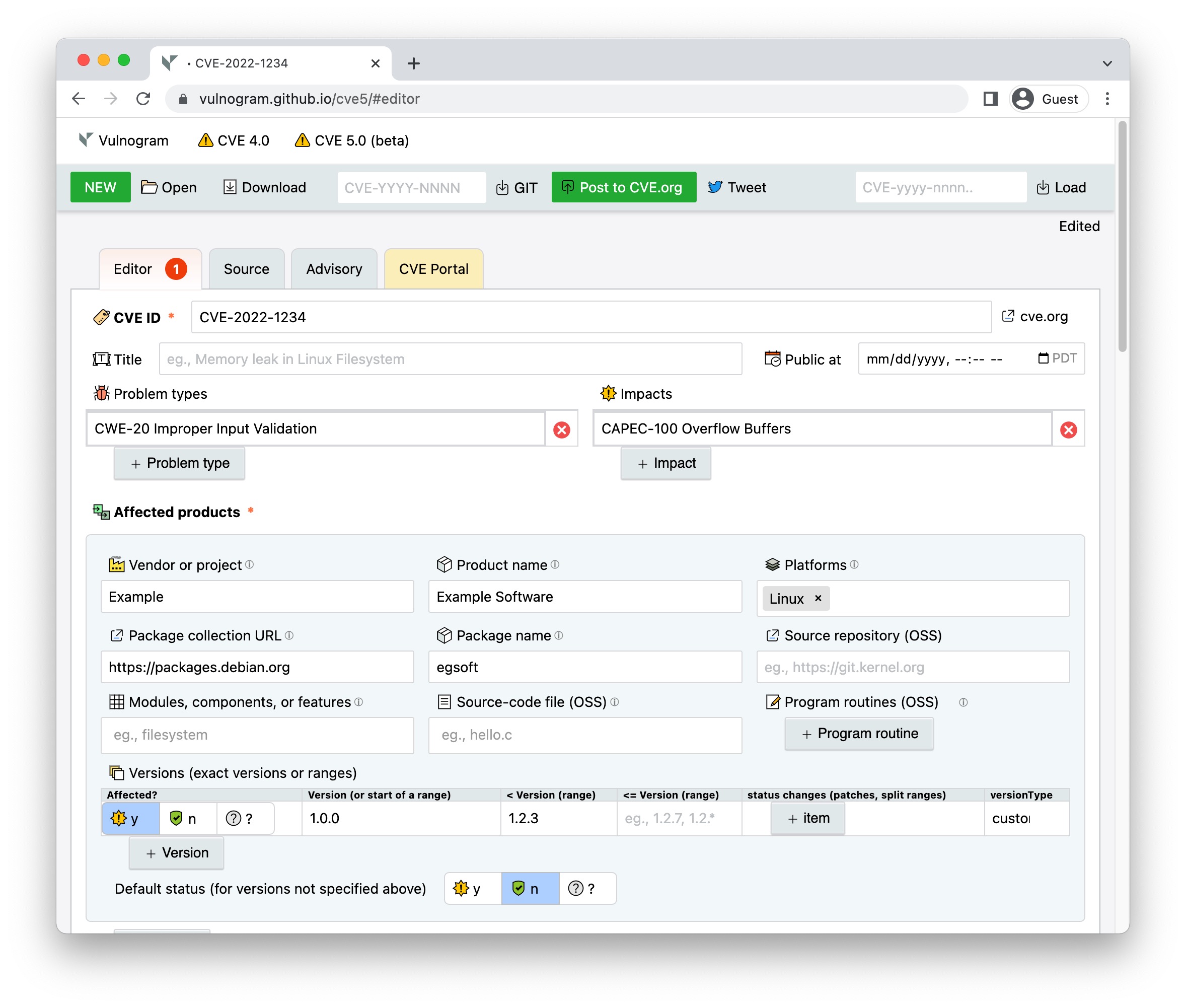Making the world safer one CVE ID at a time, since 2017.
Vulnogram is a tool for creating and editing CVE information in CVE JSON format, and for generating advisories.
The name Vulnogram is inspired from Greek origin suffix '-gram' which is used for denoting something written or recorded especially in a certain way. Vulnerability related information when recorded in a standard format can help in aggregation, curation, dissemination, analysis and remediation. This enables automation and efficiency in response activities.
Vulnogram project aims to make it easier for vendors and security researchers to accurately record vulnerability information for inclusion in the CVE List.
Vulnogram can be deployed in two modes:
| Browser mode | Server mode |
|---|---|
| Frontend web UI only, as seen on vulnogram.github.io. | A NodeJS web application serves frontend web UI for a backend Mongodb. |
| It is a Javascript based tool to open, import, edit, preview and save JSON documents which conform to a given JSON-Schema. | It is a modern scalable issue tracker similar to JIRA or bugtrack but using JSON-Schemas as data models and a NoSQL database as a backend. Along with customizable plugins it can be used for tracking anything that can be expressed with a JSON-Schema. plugins are available for tracking security incidents, tickets, contacts, NVD entries and CVE assignments. |
| Can't save CVE JSON drafts. | JSON documents are saved to a NoSQL (Mongodb) backend. |
| No login required. | Users are authenticated. |
| No workflow or tracking. | Allows tracking, querying, searching, version control, audit trail of changes, commenting and dashboard charts and graphs on collections of JSON documents. |
| Security considerations: 👍 Information entered in the tool is not transmitted anywhere out of the browser. ℹ️ Download button saves the JSON document in the browser to a local file. |
Security considerations: ℹ️ Configure HTTPS in the config file. |
$ cd vulnogram
$ npm install
... this should install required dependencies ...
See https://www.mongodb.com/
Important: Ensure mongodb authentication is enabled. It is recommended to run mongodb bound to loopback/localhost and not expose it to network.
See config/conf-default.js comments for hints
Step 4 (Optional). Copy the "default" directory as "custom" and modify relevant pug templates, schemas or routes. Files or fields from "custom" override "default".
$ node scripts/pug2js.js
$ node useradd.js tester [email protected] Tester [email protected] 1
Enter Password: ********************************************
Enter Password again: ********************************************
Success New user is now registered and can log in: tester
$ npm start
> [email protected] start /home/vulnogram/
> forever start --id 'vulnogram' --spinSleepTime 5000 --minUptime 2000 app.js
info: Forever processing file: app.js
info: Forever processes running
data: uid command script forever pid id logfile uptime
data: [0] v3wE /usr/bin/node app.js 11208 11210 vulnogram /home/vulnogram/.forever/v3wE.log 0:0:0:0.23
http://localhost:3555/ or https://localhost:3555/ depending on configuration.
$ make min
This creates standalone /index.html with minimized javascript and stylesheets can be hosted independently on websites serving static files. This does not require the backend mongodb server or the nodejs server application to be running.
Note: Opening the index.html as a file URL may not work since some browsers (including Chrome) will not run async requests on file:// URLs. It is recommended to serve these files from a webserver. See https://developer.mozilla.org/en-US/docs/Learn/Common_questions/set_up_a_local_testing_server for examples on how to run a simple testing webserver.
This project uses or depends on software from
- NodeJS https://nodejs.org/
- Express https://github.com/expressjs
- Mongodb
- Passportjs http://passportjs.org/
- Pug https://pugjs.org/
- ACE editor https://ace.c9.io/
- JSON Schema based editor https://github.com/jdorn/json-editor
- tablesort v5.0.1 https://github.com/tristen/tablesort
- cvssjs https://github.com/cvssjs
- json-patch-extended
- querymen
- linkifyjs
- pptxGenJS
Copyright (c) 2017-2019 Chandan B N.
SPDX-License-Identifier: MIT
